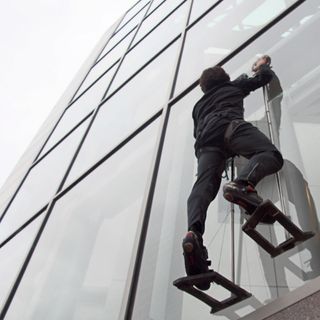Gecko Tech: Sticky Invention Lets People Scale Walls

Like Spider-Man scaling skyscrapers, people may someday climb glass walls with the help of a gecko-inspired invention, researchers say.
In addition to futuristic gear used by soldiers and spies to climb walls, the researchers suggest their new invention could lead to boots that help astronauts conducting spacewalks and to mechanical grippers that snag debris in orbit.
The invention was inspired by gecko feet. These reptiles can scale vertical walls and even hang upside down because their plump toes are covered in hundreds of microscopic bristles called setae, which generate a kind of electric force known as van der Waals force, strong enough to keep geckos stuck onto surfaces. [Biomimicry: 7 Clever Technologies Inspired by Nature]
Science of stickiness
Scientists discovered how gecko stickiness works more than a decade ago, and since then, researchers have developed many synthetic adhesives with geckolike properties, such as reusability. Advances based on such technology include medical adhesives that can seal wounds.
But one problem that both real geckos and synthetic materials face is that they cannot support as much weight as one would predict from the total area of adhesive surface they possess. For instance, a machine known as Stickybot, created by researchers at Stanford University, had enough geckolike adhesive to support an 11-pound (5 kilograms) load, but in practice, the machine could support only a tenth of that weight.
"We noticed our device wasn't performing to its highest potential, and engineers hate inefficient things," said lead study author Elliot Hawkes, a mechanical engineer at Stanford.
Sign up for the Live Science daily newsletter now
Get the world’s most fascinating discoveries delivered straight to your inbox.
Now Hawkes and his colleagues have outdone nature with new gecko-inspired devices that they have used to climb glass walls. The devices are about the size of a human hand but are nevertheless strong enough to support the weight of a person.
In contrast, if one were to somehow try climbing walls with real gecko feet, a climber weighing about 155 lbs. (70 kg) would require a sticky surface at least 186 square inches (1,200 square centimeters) large. In comparison, a modern tennis racket has an area of about 105 square inches (675 sq. cm).
How it works
The device consists of two plates that a climber holds. Each plate is covered with 24 tiles, each about 1 square inch (6.4 sq. cm) in size, or about as large as a postage stamp. Each tile is covered with tiny silicon rubber hairs about 100 microns high, or as tall as an average human hair is wide.
Each tile is connected to the rest of the device by a tendonlike string that ends in a spring made of an alloy known as nitinol. Unlike most springs, which get stiffer when they stretch out, nitinol springs become less stiff the more they stretch.
By cleverly arranging the tendons, the researchers ensured that a climber's weight gets spread evenly across each tile.
"I was the climber in the tests," Hawkes said. "That was extremely exciting. To be able to climb glass felt a little bit magical — it feels like you're hooking this device onto a perfectly flat smooth surface, and it doesn't feel possible." [Science Fact or Fiction? The Plausibility of 10 Sci-Fi Concepts]
Real geckos and previous synthetic geckolike devices distribute weight in such a way that some patches of adhesive support more weight than their neighbors. "Then, when one tile gets overloaded with weight, it will fail, and then its neighbors will fail, and such failure will propagate like an avalanche," said study co-author Mark Cutkosky, a mechanical engineer at Stanford.
The new devices support what are essentially pedals that a climber places his or her feet in. This way the climber's weight is pulling on the adhesive tiles and not on the climber's arms. "It feels like a movable ladder, like I'm placing a new rung with each step," Hawkes said.
"To stick the adhesive onto a surface, you just step on the surface, and to lift it off, you just take your weight off the surface," said study co-author Eric Eason, an applied physicist at Stanford.
Hawkes neither climbs as a hobby nor professionally. "I wanted to design a system that an everyday person could use," he said.
Gecko-inspired tech
In June, researchers at the U.S. Department of Defense had reported developing a set of gecko-inspired handheld paddles that could support a 218-lb. (99 kilograms) man carrying a 50-lb. (23 kg) pack while he scaled a 25-foot-high (7.6 meters) glass wall. However, these paddles are much larger than the new devices that Hawkes and his colleagues have developed.
The scientists are now looking to use their adhesive to snag garbage in space. Orbital debris can cause a lot of damage by slamming into spacecraft, astronauts and satellites at speeds much faster than bullets. Magnets would not do well at capturing space junk because many structures in space are made of materials that are, at best, weakly attracted by magnetic fields. Suction cups are similarly not a viable solution, since they only work in air, not in the vacuum of space, and many other adhesives would freeze and crack in the cold of space.
"We're working on a project to build a 'garbage truck' satellite that can grab space junk and remove it either to a graveyard orbit or to the atmosphere where it can burn up," Hawkes said.
Applications closer to Earth may include manufacturing robots to grasp panes of glass, solar panels and video screens. The technology could also be used to develop climbing robots "to inspect or clean windows," Eason said. Sticky pads could also help flying robot drones cling onto windows, Hawkes said.
The scientists detailed their findings online Nov. 18 in the journal Interface.
Follow Live Science @livescience, Facebook & Google+. Original article on Live Science.

Most Popular

